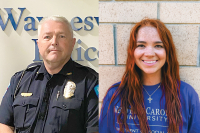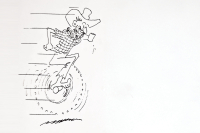WCU study to determine faculty satisfaction rate
Employees at Western Carolina University are distilling the recently released results of a Harvard University study to see if regional comprehensive universities have lower faculty satisfaction rates.
What makes you stay: Survey evaluates faculty experience at WCU
 Every three years, Western Carolina University gets a report card.
Every three years, Western Carolina University gets a report card.
It does not prescribe the university an A, B, C or even F, but the report does tell WCU what it does right and where it needs to improve. Then, it instructs the university to do better.
“It’s not ‘this is your grade’ and you’re done,” said Mark Lord, WCU’s interim associate provost. “It’s really supposed to be a call to action.”
WCU opens up the door for wine and beer sales at performance venue
People attending productions at Western Carolina University’s John W. Bardo Fine and Performing Arts Center may soon have the chance to enjoy a glass of wine or a beer before a show or during intermission.
WCU’s board of trustees Friday unanimously approved a policy change allowing for the sale of beer and wine at the performance venue.
Drinking up the essence of thought, innovation
 It’s a room full of strangers, ideas and alcohol.
It’s a room full of strangers, ideas and alcohol.
Still in its infancy yet gaining steam, the Drink-N-Think congregation came together last Wednesday evening at the Mad Batter Bakery & Café in Cullowhee, near the heart of Western Carolina University.
Jungle king swings into WCU
 A cold wind howls through the campus of Western Carolina University as the screams of a young woman echo from a nearby building.
A cold wind howls through the campus of Western Carolina University as the screams of a young woman echo from a nearby building.
The voice is Stefani Cronley and her attackers are a gang of apes.
River park could catapult Old Cullowhee revitalization
Champions of Cullowhee revitalization are chipping away at a lofty plan to create a vibrant college downtown centered on the banks of the Tuckasegee River in Old Cullowhee.
Growth prompts call for Cullowhee land-use plan
 Cullowhee community members have been making their case for nearly a year now that this pseudo-college town needs land-use planning to guide the growth that’s come knocking.
Cullowhee community members have been making their case for nearly a year now that this pseudo-college town needs land-use planning to guide the growth that’s come knocking.
WCU hastens Millennial build-out
In an effort to speed development of its Millennial Campus, Western Carolina University plans to lease the 344-acre tract to a nonprofit endowment — streamlining regulations and eliminating some of red tape the institution must otherwise cut through as a state entity.
150 and counting: WCU grad student research helps get a handle on impacts of mounting numbers of elk
 By Jill Ingram • Guest writer, WCU public affairs office
By Jill Ingram • Guest writer, WCU public affairs office
Covering long distances in and around Cataloochee Valley, a Western Carolina University student is researching the growing, and sometimes problematic, elk population in the Great Smoky Mountains National Park. The goal is to provide park rangers with data to help manage the herd.
Elizabeth Hillard, a 30-year old graduate student in biology, has gone to great lengths to find out whatever she could about the creatures.
The art of stereotyping: Have Southerners gotten a fair shake from pop culture?
 Times may change, but stereotypes tend to linger.
Times may change, but stereotypes tend to linger.
Venturing into the off-color humor and often offensive images of Southern culture portrayed by cartoonists throughout American history, Western Carolina University will address the issue head-on in its newest exhibit opening next week.









